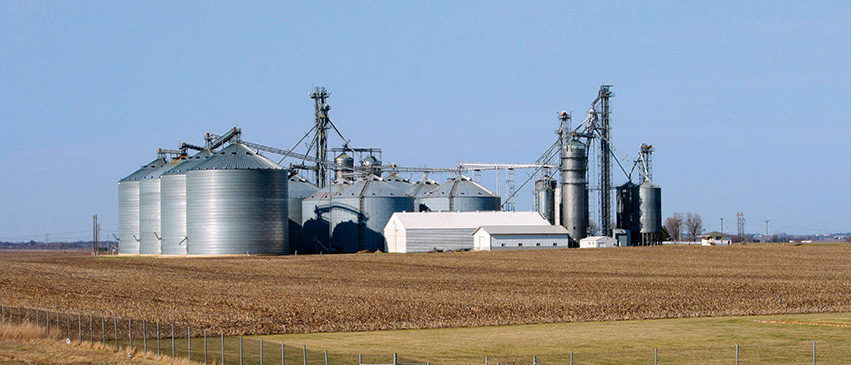Where Has All the Corn Gone?

Did you know that Illinois is the leading producer of soybeans and second-leading producer of corn in the United States? In 2019, central Illinois alone accounted for an estimated 1.5 million planted acres, producing over 290 million bushels of corn. Every summer, you can drive what seems like any stretch of road and look out your window to see endless rows of cornfields. And then, suddenly in the fall, it’s all gone.
Where did all the corn go? This type of corn—known as field corn—was not grown to be eaten as what is commonly called sweet corn. It was likely sold by farmers to local grain elevators to eventually make its way “down the river” to be exported or processed for different uses, such as feed or renewable ethanol fuel.
This answer may raise even more questions: What exactly is a grain elevator? What does a grain elevator do? How does the grain industry work?
A Complex System
Grain elevators buy and sell farmers’ grain, which is called merchandising. Country grain elevators provide convenient destinations for farmers to deliver and sell their grain. These types of grain elevators can vary in size, but typically consist of one or more grain bins (large storage structures), grain testing equipment, truck scales, equipment to move the grain, and usually an office building or two. From a country elevator (or sometimes directly from farmers), grain is moved to larger terminal grain elevator locations, typically found at major transportation hubs with access to rail or river barge systems to meet buyers’ needs for export or production.
Grain pricing is based on the Chicago Board of Trade, or some other applicable exchange, and changes throughout each trading day. This article is not intended to be a comprehensive thesis on the intricate details of grain markets—feel free to Google “grain hedging,” “margin calls” or “spread trading” if you want to take a deeper dive. The biggest takeaway should be that the grain industry, which plays a vital role in agriculture and the local economy in general, is a complex system affected by various factors, both internal and external.
Protection Under the Law
Most local farmers have some protection provided by Illinois law. The rarely publicized Illinois Grain Code was enacted on January 1, 1996 in an effort to deal with unique issues in the grain industry both before and after problems arise. Under the watchful eye of the Illinois Department of Agriculture, the grain industry is a heavily regulated sector of the economy.
Grain elevators are required to be licensed as grain dealers (those who buy grain), grain warehousemen (those who store grain), or both. Those licensees are subject to inspections and auditing by the Department of Agriculture and must keep meticulous records to demonstrate their financial wherewithal. However, no regulatory system is perfect. Although it is a rarity, sometimes a grain elevator fails. When there is no alternative, farmers can turn to the Grain Insurance Fund that was created under the Grain Code and file a claim for compensation if they have suffered a loss.
Navigating the Business
The business of farming is not simple. Agriculture is a complex system that involves significant risk management as well as government oversight and regulation, especially under the Illinois Grain Code. In desperate times, this system may provide a much-appreciated safety net.
And like any other business, the agriculture industry needs the assistance of professionals, such as attorneys and accountants, to help navigate not only the common problems faced by any business, but also the unique issues associated with the trade of grain. PM
Hasselberg Grebe Snodgrass Urban & Wentworth offers over 30 years of experience representing the grain industry and counseling clients on agricultural issues. For more information, visit hgsuw.com.
